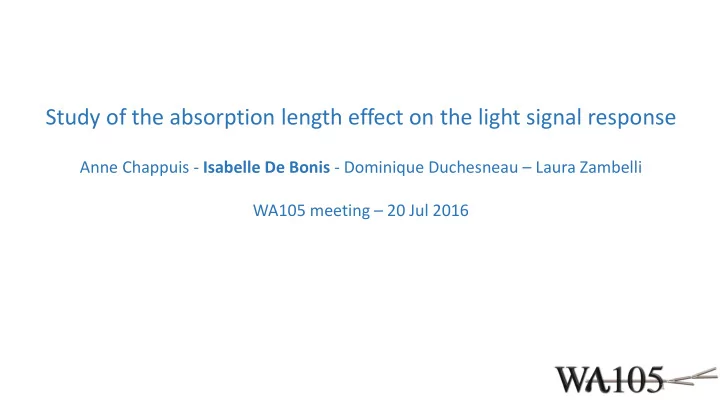

Study of the absorption length effect on the light signal response Anne Chappuis - Isabelle De Bonis - Dominique Duchesneau – Laura Zambelli WA105 meeting – 20 Jul 2016 1
Introduction • Last SB meeting (6 jul 2016) we have presented for various absorption lengths a comparison between Geant4 simulation results and a classical absorption model with an exponential exp(-travelled distance/ l ABS ) used by Qscan studies. l ABS = 4 m In blue : l ABS = 30 m Geant4 travelled time distribution In red : Travelled time distribution obtained by using the l ABS = ∞ distribution * exp ((-travelled time * C/n)/ l ABS ) n : refractive indice of LAr Travelled time (ns) Travelled time (ns) • We have improved this study by increasing the statistics and for various photons generation points in the detector. • I present here the updated results. Reminder : Rayleigh scattering and reflectivity effects are taken into account: Rayleigh scattering length l RS = 55 cm for VUV and Field cage and Tank surface : 100% absorption
Comparison between Geant4 simulation results and a classical absorption model with an exponential exp(-travelled distance/ l ABS ) 10 7 photons generated at the detector center ( X=0, Y=0, Z=0 ) l ABS = 30 m l ABS = 10 m --- Geant4 --- Model Loss in % = (N Geant4 – N Model )/N Geant4 l ABS = 30m 4.9 % l ABS = 10m 10.4 % Travelled time (ns) Travelled time (ns) l ABS = 4m 19.9 % l ABS = 2m 30.5 % l ABS = 4 m l ABS = 2 m The loss increases when the absorption length decreases Travelled time (ns) Travelled time (ns)
Comparison between Geant4 simulation results including absorption processus and a classical absorption model with an exponential exp(-travelled distance/ l ABS ) 10 7 photons generated at the bottom of the detector ( X = 0 mm, Y = 0, Z = - 2500 mm ) l ABS = 30 m Loss in % = (N Geant4 – N Model )/N Geant4 l ABS = 10 m --- Geant4 l ABS = 30m 2.1 % --- Model l ABS = 10m 5.2 % l ABS = 4m 8.2 % l ABS = 2m 11.1 % Travelled time (ns) Travelled time (ns) The loss is reduced when the photons l ABS = 4 m l ABS = 2 m are generated at the bottom of detector This may be explained by the fact that the photons are less subject to Rayleigh scattering Travelled time (ns) Travelled time (ns)
Comparison between Geant4 simulation results including absorption processus and a classical absorption model with an exponential exp(-travelled distance/ l ABS ) 10 7 photons generated near the field cage surface ( X = 2800 mm, Y = 0, Z = 0 ) Absorption of field cage surface = 100% l ABS = 30m l ABS = 10 m Loss in % = (N Geant4 – N Model )/N Geant4 --- Geant4 --- Model l ABS = 30m 3.1 % l ABS = 10m 9.8 % l ABS = 4m 16.6 % l ABS = 2m 25.1 % Travelled time (ns) Travelled time (ns) The loss is reduced when the photons are generated near the field cage l ABS = 4 m l ABS = 2 m surface. This may be explained by the fact that more photons are absorbed by the surface Travelled time (ns) Travelled time (ns)
Conclusion This comparison shows that the difference between Geant4 and the model is dependant of --- the absorption length --- the position in the detector Thus a more carefull study is needed to use the modelisation instead of Geant4 simulation.
Recommend
More recommend